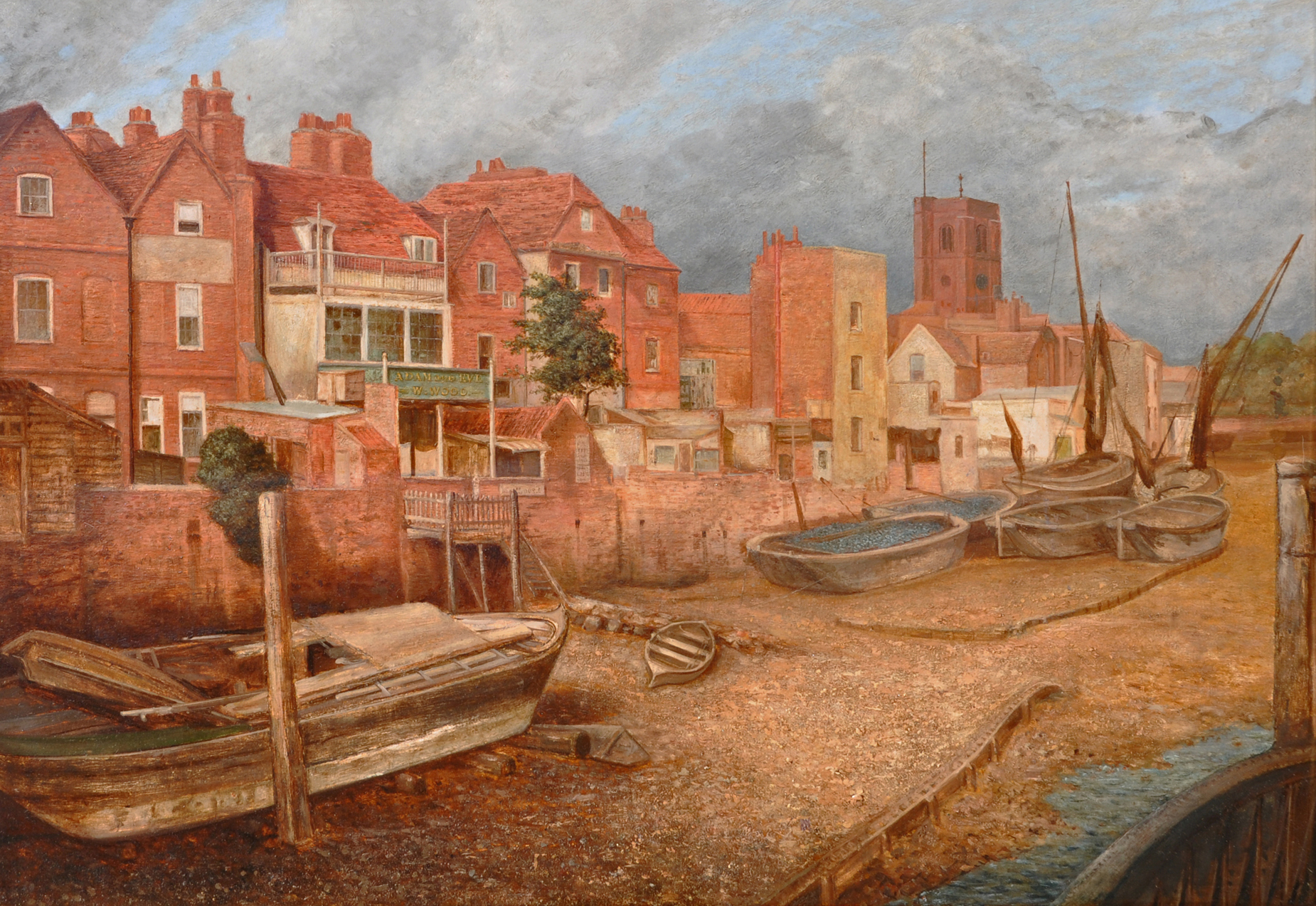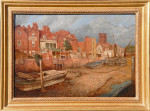A view of the Thames foreshore at Chelsea with the Adam and Eve pub
A view of the Thames foreshore at Chelsea with the Adam and Eve pub
ENGLISH SCHOOL c. 1850
A view of the Thames foreshore at Chelsea with the Adam and Eve pub
Oil on board laid down, indistinctly inscribed on label on reverse
43 x 64.2 cms
167/8 x 251/4 inches
Overall framed size 53.7 x 74 cms
211/8 x 291/8 cms
This painting depicts a view of Chelsea from the River Thames at low tide with moored barges in the foreground and the Adam and Eve overlooking the river. It was a popular subject with painters of London and Walter Greaves (1846-1934) and James Abbott McNeill Whistler (1834-1903) both produced views of this stretch of the river and examples of them can be seen in the London Museum, Government Art Collection and the National Maritime Museum. Walter Greaves and his brother were both local artists and the family had worked as ferrymen. Their father had rowed J M W Turner and the sons had ferried Whistler to destinations along the river.
Chelsea, which in Faulkner’s History of Chelsea, is defined as being “…bounded on the north by the Fulham Road, which separates it from Kensington; on the east by a rivulet, which divides it from St George’s, Hanover Square, and which enters the Thames near Ranelagh; on the west a brook, which rises near Wormholt Scrubs, and falls into the Thames facing Battersea Church, divides this parish from that of Fulham.
In 787, Offa, King of the Mercians, held a Synod in the area and around 799 a church was probably founded although there is no official record of it until1157. Probably the earliest record of the name appears in a charter of Edward the Confessor where it is written as Cealchylle. The Anglo-Saxon spelling seems to have confused the Norman scribes of the Domesday Book as it is recorded as being a village in Middlesex as Cercehede and as Chelched. Sometime later the spellings Chelcheth and Chelcith make an appearance before Chelsey was first adopted in the 16th century and the modern version entered common usage in the 18th century. There has been some debate about the etymological root of the name but the most probable derives from Anglo-Saxon ceosel or cesol, becoming chisel, which describes an area of washed up pebbles and sand and is still apparent in Chesil Beach near Weymouth and even Selsey near Chichester which has a peninsular of pebbles.
At the end of the Carolean age Chelsea was a “…quiet country village, with about a thousand inhabitants” and the water was so clear and pure that even Charles II bathed there. Faulkner wrote of an event in 1796 that he witnessed at first-hand : “ I was present at a stag-hunt in Chelsea. The animal swam across the river from Battersea, and made for Lord Cremorne’s grounds. Upon being driven from thence, he ran along the water-side as far as the church, and turning up Church Lane, at last took refuge in Mrs Hutchin’s barn, where he was taken alive” Chelsea gradually became absorbed into the greater metropolis while still retaining some of its old buildings and charm
There were once many public houses in the Chelsea area, particularly along the water’s edge, one of them being The Aquatic on Cheyne Walk with J M W Turner spending the last years of his life next door at number 119.
The Adam and Eve probably originated in the 17th century and the second floor gallery, clearly evident in the painting, provided fine views over the river and the busy commerce going on there. That particular area of Chelsea was originally marsh land upon which there was an abundance of water fowl and apparently the walls of the public house were adorned with a collection of hunting equipment used in the shooting of these birds.
As one looks downstream in the painting, Allen’s Lime Wharf and Old Ferry Wharf are depicted with a flat-fronted building almost on the river wall. This was the establishment of John Johnson, a coal merchant, and the laden beached coal barges can be discerned. His address is recorded in directories as Old Ferry Wharf, Duke St., Chelsea and apart from being listed as a coal merchant he is also described as lighterman and carman. It seems that he and his family had several businesses in London as there was an Oatly and Johnson at Hungerford Market Wharf and another at the Midland Coal Depot at King’s Cross Station.
Further downstream, beyond the wharves, is the tower of Chelsea Old Church also known as All Saints. The Norman church of 1157 did not gain the name of All Saints until 1290. There is a medieval chancel and the north chapel, which dates from the first quarter of the 14th century, was the preserve of the Lord of the Manor of Chelsea and there is a squint in the east arch which enabled him to view of the altar. The south chapel was rebuilt in 1528 by Sir Thomas More for his personal use.
All of these waterside buildings, but not the church as it was in land from the river, were pulled down to enable the building of the Embankment, the major work of the Chief Engineer of the Metropolitan Board of Works, Sir Joseph Bazalgette. Opened on 9th May 1874, it controlled the Thames tidal surges and alleviated the flooding and sewage problems that had been part of much of London at ground level.
Bibliography:
Old and New London Volume V – Edward Wolford
The London Encyclopaedia – Ben Weinreb, Christopher Hibbert, Julia Keay, John Keay
Simpson's Kensington and Hammersmith directory and court guide ..., London, 1863; Kelly's London Post Office Directory, London, 1861, 1862 and 1864.
My London walks blog
National Maritime Museum website
RELATED ITEMS























